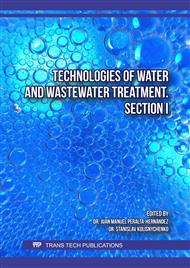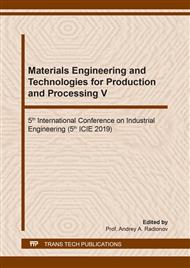[1]
Yu. Yao, Ji. Qin, H. Chen, F. Wei, X. Liu, Ji. Wang, S. Wang, One-pot approach for synthesis of N-doped TiO2/ZnFe2O4 hybrid as an efficient photocatalyst for degradation of aqueous organic pollutants, J. of Hazardous Mat. 291 (2015) 28-37.
DOI: 10.1016/j.jhazmat.2015.02.042
Google Scholar
[2]
Jin R. Jin, H. Liu, Ya. Guan, Ju. Zhou, G. Chen, ZnFe2O4/C nano discs as high performance anode material for lithium-ion batteries, Mat. Lett. 158 (2015) 218-221.
DOI: 10.1016/j.matlet.2015.06.030
Google Scholar
[3]
X. Zhou, Ji. Liu, C. Wang, P. Sun, X. Hu, X. Li, K. Shimanoe, N. Yamazoe, G. Lu, Highly sensitive acetone gas sensor based on porous ZnFe2O4 nanospheres, Sensors and Actuators B. 206 (2015) 577-583.
DOI: 10.1016/j.snb.2014.09.080
Google Scholar
[4]
T. Ono, D. Oharu, S. Kobayashi, H. Yamada, S. Takita, M. Maeda, K. Takase, Y. Takano, T. Watanabe, Element substitution effects on magnetic properties of spin-frustrated spinel Znb2O4 (B = Cr and Fe), Solid State Phenomena 257 (2017) 111-114.
DOI: 10.4028/www.scientific.net/ssp.257.111
Google Scholar
[5]
M.R.M. Shafiee, M. Sadeghian, M. Kargar, ZnFe2O4-Fe2O3-CeO2 composite nanopowder: Preparation, magnetic properties, and 4-chlorophenol removal characterizations, Ceramics International 43, Issue 16 (2017) 14068-14073.
DOI: 10.1016/j.ceramint.2017.07.142
Google Scholar
[6]
Z. Krysieki, T. Lubanska, Effect of the presintering process on the microstructure and initial permeability of Mn–Zn ferrite, J. Magn. and Magn. Mater. 1-3 (1980) 107-108.
Google Scholar
[7]
M. Ajmal, A. Maqsood, Influence of zinc substitution on structural and electrical properties of Ni1-xZnxFe2O4 ferrites, Mat. Science and Engineering B. 139 (2007) 164–170.
DOI: 10.1016/j.mseb.2007.02.004
Google Scholar
[8]
S.S. Kumbhar, M.A. Mahadik, S.S. Shinde, K.Y. Rajpure, C.H. Bhosale, Fabrication of ZnFe2O4 films and its application in photoelectrocatalytic degradation of salicylic acid, J. of Photochemistry and Photobiology B: Biology. 142 (2015) 118–123.
DOI: 10.1016/j.jphotobiol.2014.12.002
Google Scholar
[9]
Z. Xu, S. Gu, S. Huang, K. Tang, Ji. Ye, S. Zhu, M. Xu, Yo Zheng, Structure and properties of Fe3O4 films grown on ZnO template via metal organic chemical vapor deposition. J. of Magnetism and Magnetic Mat. 385 (2015) 257–264.
DOI: 10.1016/j.jmmm.2015.03.018
Google Scholar
[10]
P. Priyadharsini, A. Pradeep, G. Chandrasekaran, Novel combustion route of synthesis and characterization of nanocrystalline mixed ferrites of Ni–Zn, J. of Magnetism and Magnetic Mat. 321 (2009) 1898-1903.
DOI: 10.1016/j.jmmm.2008.12.005
Google Scholar
[11]
Ja,Y. Patil, D.Y. Nadargi, Jy.L. Gurav, I.S. Mulla, S.S. Suryavanshi, Glycine combusted ZnFe2O4 gas sensor: Evaluation of structural morphological and gas response properties, Cer. Intern. 40 (2014) 10607-10613.
DOI: 10.1016/j.ceramint.2014.03.041
Google Scholar
[12]
S.M. Masoudpanah, S.A.S. Ebrahimi, M. Derakhshani, S.M. Mirkazemi, Structure and magnetic properties of La substituted ZnFe2O4 nanoparticles synthesized by sol–gel autocombustion method, J. of Magnetism and Magnetic Mat. 370 (2014) 122-126.
DOI: 10.1016/j.jmmm.2014.06.062
Google Scholar
[13]
S.A. Hosseini, M.C. Alvarez-Galvan, J.L.G. Fierro, A. Niaei, D. Salari, MCr2O4 (M=Co, Cu and Zn) nanospinels for 2-propanol combustion: Correlation of structural properties with catalytic performance and stability, Cer. Intern. 39 (2013) 9253-9261.
DOI: 10.1016/j.ceramint.2013.05.033
Google Scholar
[14]
E.R. Kumar, T. Arunkumar, T. Prakash, Heat treatment effects on structural and dielectric properties of Mn substituted CuFe2O4 and ZnFe2O4 nanoparticles, Superlattices and Microstructures. 85 (2015) 530-535.
DOI: 10.1016/j.spmi.2015.06.016
Google Scholar
[15]
X. Zhu, F. Zhang, M. Wang, Ji. Ding, S. Sun, Ju.Bao, C. Gao, Facile synthesis, structure and visible light photocatalytic activityof recyclable ZnFe2O4/TiO2, Applied Surface Science. 319 (2014) 83-89.
DOI: 10.1016/j.apsusc.2014.07.051
Google Scholar
[16]
R. Zhang, X. Yang, D. Zhang, H. Qiu, Q. Fu, H. Na, Z. Guo, F. Du, G. Chen, Yi. Wei, Water soluble styrene butadiene rubber and sodium carboxyl methyl cellulose binder for ZnFe2O4 anode electrodes in lithium ion batteries, J. of Power Sources. 285 (2015) 227-234.
DOI: 10.1016/j.jpowsour.2015.03.100
Google Scholar
[17]
A. Shanmugavani, R. KalaiSelvan, S. Layek, C. Sanjeeviraja, Size dependent electrical and magnetic properties of ZnFe2O4 nanoparticles synth esized by the combustion method: Comparison between aspartic acid and glycine as fuel, J. of Magnetism and Magnetic Mat. 354 (2014) 363-371.
DOI: 10.1016/j.jmmm.2013.11.018
Google Scholar
[18]
M. Zhao, S. Fan, Ji.Liang, Yi. Liun, Yi. Li, Ji. Chen, S. Chen, Synthesis of mesoporous grooved ZnFe2O4 nano belts as peroxidase mimetics for improved enzymatic biosensor, Cer. Intern. 41 (2015) 10400-10405.
DOI: 10.1016/j.ceramint.2015.04.080
Google Scholar
[19]
F. Mueller, D. Bresser, E. Paillard, M. Winter, S. Passerini, Influence of the carbonaceous conductive network on the electrochemical performance of ZnFe2O4 nanoparticles, J. of Power Sources. 236 (2013) 87-94.
DOI: 10.1016/j.jpowsour.2013.02.051
Google Scholar
[20]
A. Esmaeili, N.A. Hadad, Preparation of ZnFe2O4–chitosan-doxorubicin hydrochloride nanoparticles and investigation of their hyperthermic heat-generating characteristics, Cer. Intern. 41 (2015) 7529-7535.
DOI: 10.1016/j.ceramint.2015.02.075
Google Scholar
[21]
N. Kumari, V. Kumar, S.K. Singh, Effect of Cr3+ substitution on properties of nano-ZnFe2O4, J. of Alloys and Compounds. 622 (2015) 628-634.
DOI: 10.1016/j.jallcom.2014.10.083
Google Scholar
[22]
O.V. Yelenich, S.O. Solopan, T.V. Kolodiazhnyi, V.V. Dzyublyuk, A.I. Tovstolytkin, A.G. Belous, Magnetic properties and high heating efficiency of ZnFe2O4 nanoparticles, Mat. Chem. and Physics. 146 (2014) 129-135.
DOI: 10.1016/j.matchemphys.2014.03.010
Google Scholar
[23]
L. Liu, A. Han, M. Ye, W. Feng, , The evaluation of thermal performance of cool coatings colored with high near-infrared reflective nano-brown inorganic pigments: Magnesium doped ZnFe2O4 compounds, Solar Energy. 113 (2015) 48-56.
DOI: 10.1016/j.solener.2014.12.034
Google Scholar
[24]
N.P. Shabel'skaya, V.V. Ivanov, V.M. Talanov, L.A. Reznichenko, M.V Talanov, A.K. Ul'yanov, Synthesis and phase formation in the system NiO-CuO-Fe2O3-Cr2O3, Glass and Ceramics. 71 (2014), Nos. 1-2, 18-22.
DOI: 10.1007/s10717-014-9607-0
Google Scholar
[25]
V.M. Chernyshev, N.P. Shabelskaya, Comparative analysis of catalytic activity in complex NiO-CuO-Fe2O3-Cr2O3 oxide system of different production technologies, Materials Science Forum. 870 (2016) 118-122.
DOI: 10.4028/www.scientific.net/msf.870.118
Google Scholar
[26]
N.P. Shabelskaya, Synthesis and Properties of Binary Spinels in a NiO-CuO-Fe2O3-Cr2O3 System, Glass Physics and Chemistry. 43 (2017), Is. 1, 240-245.
DOI: 10.1134/s1087659617030129
Google Scholar
[27]
N.P. Shabel'skaya, Phase Formation Processes in the NiO – CuO – Fe2O3 – Cr2O3 System upon Salt Decomposition, Inorganic Mat. 50 (2014), No. 11, 1114-1118.
DOI: 10.1134/s002016851411017x
Google Scholar



